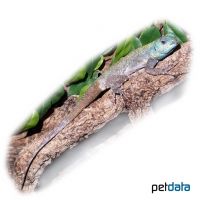Black-necked Agama (Acanthocercus atricollis)
| Black-necked Agama Acanthocercus atricollis | |
|---|---|
| Name | Black-necked Agama |
| Name Lat. | Acanthocercus atricollis |
| Synonym | Agama atricollis |
| Family | Agamas |
| Family lat. | Agamidae |
| Order | Scaled Reptiles |
| Order lat. | Squamata |
| Origin | Africa |
| Habitat | Savanna |
| Diet | Insects, herbs, fruits |
| Humidity | 50-70 % |
| Behavior | ♂ territorial |
| Keeping | Individual, pair, harem |
| Care Level | Moderate |
| Reproduction | Oviparous |
| Housing | Semi-humid terrarium |
| Life Span | 10-12 years |
| Protection | No |
| Metric Units | |
| Size | 30 cm |
| Temperature | 25-33 °C |
| Temperature Local | 40-45 °C |
| Housing Size | 120 x 60 x 60 cm |
| US Units | |
| Size | 12" |
| Temperature | 77-91 °F |
| Temperature Local | 104-113 °F |
| Housing Size | 45" x 25" x 25" |
Distribution and habitat
The diurnal blue-throated gagams are widespread in East Africa, from Ethiopine to South Africa. They live in the tree savannahs and sparse forests, where they usually stay in cairns or on bushes and trees.
Maintenance
Minimum dimensions for the terrarium, according to the size and number of animals
| 1-2 animals | 5KRL x 3KRL x 4KRL (L x W x H) |
Head-torso length (KRL) is measured on the largest animal. For each additional animal, increase the footprint by 15%. Ideal is a terrarium of e.g. L 120 x W 60 x H 80 cm, which should be placed in a quiet and vibration-free place.
You will need a terrarium structured with roots, climbing branches, stone structures (hiding places and privacy screens) and sunning spots, a substrate of sand/clay mixture and rubble, a small water container and potted plants (e.g. euphorbia, aloe, oleander). A small portion of the substrate should always be kept moist. Once a day, preferably in the evening, the inside of the terrarium should be finely sprayed with water, but not directly the animals (risk of shock)
| Temp. day: 25-33 °C | Temp. night: 18-22 °C | Temp. local: up to 45 °C | Humidity: 50-70 |
Thermostatically controlled floor heating is recommended. Lighting duration must be 10-14 hrs depending on the season. They need a high light intensity. Special lamps that produce the necessary heat and UV light are ideal. Daily UV irradiation is essential.
Diet
Although in the wild they eat mainly termites and flying ants, they will also accept crickets, house crickets, smaller grasshoppers, cockroaches, zophobas and mealybug larvae; alternatively, commercially available ready-made food for insectivorous reptiles can be offered, along with occasional wild herbs, sweet fruits and fruit pulp. Wax moths should only be fed in small amounts to adults, but not to juveniles, because of their large fat content. Regular addition of minerals and vitamins (dusting of feed) is important. Young animals should be offered food daily, adult animals 4-5 times a week. Drinking water must always be available
A regular and varied diet promotes health and prevents deficiency symptoms.
Reproduction and breeding
The male has a broader head and 10-12 clearly visible preanal pores (pore-like openings in front of the anal cleft) arranged in 2-3 rows. At sexual maturity the dominant male shows its full coloration.
The female reaches sexual maturity in the 2nd year of life and buries her oval, soft-shelled eggs (8-14 eggs) in the substrate. The incubation period is 90 days at a temperature of 26-30 °C. These data are from field studies, reports of successful breeding in the terrarium are not known so far
Life expectancy can be over 10 years.
Important
Adult males behave very territorial and are incompatible with each other. Be careful when catching them, they can bite painfully
The terrarium must have good ventilation without drafts and meet the species specific needs. Measuring devices such as thermometers, hygrometers, etc. are necessary. The lighting has to correspond to the species-specific day-night rhythm and has to be placed in such a way that the animals cannot injure themselves. The terrarium should be locked in such a way that neither unauthorized persons can open it nor the animals can escape. Contamination must be removed regularly
Further literature can be found in your pet store.
References
Text: Christian Sänger; Image: petdata
Source: BMELV (1997): Mindestanforderungen an die Haltung von Reptilien; ENGELMANN (2006): Zootierhaltung - Tiere in menschlicher Obhut: Reptilien und Amphibien, Harri Deutsch Verlag; BRANCH (1994): Field Guide - Snakes and other Reptiles of Southern Afrika, Struik Publishers Ltd.
- Gemäß § 21 Abs. 5 Tierschutzgesetz idgF
